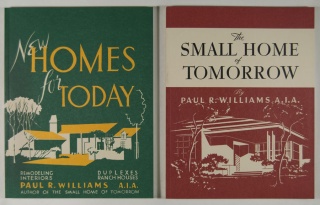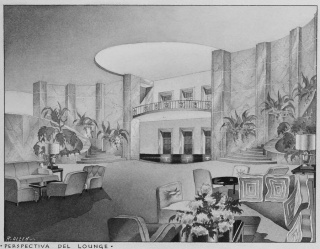Education | Timeline |
- 1829
- 1834
- 1840s
- 1848
- 1853
- 1859
- 1870
- 1870s
- 1871
- 1875
- 1877
- 1879
- 1880s
- 1882
- 1883
- 1884
- 1886
- 1887
- 1889
- 1890s
- 1891
- 1892
- 1893
- 1894
- 1895
- 1898
- 1899
- 1900
- 1900s
- 1901
- 1902
- 1904
- 1905
- 1906
- 1908
- 1909
- 1910
- 1910s
- 1911
- 1912
- 1913
- 1914
- 1915
- 1916
- 1917
- 1918
- 1919
- 1920
- 1920s
- 1921
- 1922
- 1923
- 1924
- 1925
- 1926
- 1927
- 1928
- 1929
- 1930s
- 1930
- 1931
- 1933
- 1934
- 1935
- 1936
- 1937
- 1938
- 1939
- 1940s
- 1940
- 1941
- 1942
- 1943
- 1944
- 1945
- 1946
- 1947
- 1948
- 1949
- 1950s
- 1950
- 1951
- 1952
- 1953
- 1954
- 1955
- 1956
- 1957
- 1958
- 1959
- 1960s
- 1960
- 1961
- 1962
- 1963
- 1964
- 1965
- 1966
- 1967
- 1968
- 1969
- 1970s
- 1970
- 1971
- 1972
- 1973
- 1974
- 1976
- 1979
- 1980
- 1992
Williams publishes two books
When World War II ends, 17 million service personnel return to civilian life and need affordable housing. Williams addresses this problem in two pattern books: The Small Home of Tomorrow (1945) and New Homes for Today (1946). The plans and lifestyles shown in these books reflect Williams' belief in the importance of homeownership and the future of American middle class housing. Reviews appear in the important professional journals and design magazines of the day. Architects, builders and the general public are encouraged to read them and be mindful of Williams' advise.
Paul Wiliams formulates his small house philosophy throughout his career. The early architectural competitions he enters often center on designing small, affordable housing using specific building materials. He shows progress with each submission as he imagines what these homes could be. Before he is known as the designer of impressive historic revival homes, Williams is acknowledged by his peers as a master of the small house.
Williams never stops thinking about the importance of expanding the availability of affordable housing to all Americans. In an essay published in Ebony (August 1963) Wiliams looks back on his career wistfully writing, "If I were young today I would start with the need for the development of the small home with the thought that a charming inexpensive home could be produced for the masses by forgetting the formula of houses today and mixing imagination with my thinking. What the world needs today is a new concept for a substantial, economical house."
In 2015 Phil Hall posts a thoughtful essay on the electronic publication Progress In Lending Association (February 5, 2015) reminding his readers of the timeliness of Paul Williams' smart thoughts on small homes. Williams "offered a bold challenge to home builders and property developers: create a new landscape of residential housing that was both aesthetically pleasing and efficient while keeping cost at a level that returning veterans and their families could properly afford... At a time when housing planning at every level ... seems more reactive than proactive, the concept of taking the time to think things out becomes a very attractive commmodity."
Japanese Utterly Beaten says MacArthur
Los Angeles Times, September 12, 1945
On September 2, 1945, Japan formerly surrenders to the Allies on the USS Missouri. Germany had already surrendered by May 1945. With Japan's surrender the world-wide conflict ends.
This newsreel of Japan's formal surrender plays in movie theaters around the world.
Imposing New Buildings in Colombia, S.A., Designed by Los Angeles Architect
Southwest Builder and Contractor, December 21, 1945
"Architect Paul R. Williams of Los Angeles, internationally famous for his designs, ranging from modest homes to magnificent metropolitan structures, has designed four unusually interesting buildings—one completed, one under construction, and two to be built soon—in Colombia South America."
This rendering by R. Allen of a lobby interior illustrates Williams' vision for a South American hotel.








The Wilfandel Club of Los Angeles Established
The Wilfandel Club of Los Angeles is established November 21, 1945 by a group of socially prominent African American women. Della Williams, Paul Williams' wife, is a founding member. The goal of this African American club, the oldest in the city, is to promote civic improvement, cultural and philanthropic endeavors. By the 1950s the Wilfandel club house is recognized as an integrated public meeting place—one of the few in the city.